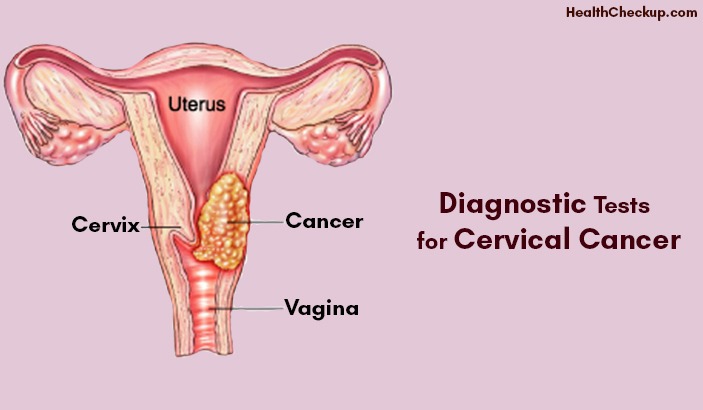Cervical cancer is one of the most prevalent forms of cancer among women that develops in the cervix (the entrance from the vagina to the womb). One of the biggest problems with cervical cancer is that it does not show any symptoms in the early stages. Therefore, doctors recommend regular cervical screening in order to prevent cervical cancer. There are also a number of tests that can be used to diagnose tests for cervical cancer at an early stage and determine its progress so that the doctor can choose the best possible treatment for the patient.
Essential Tests for Cervical Cancer
Cervical Screening:
This test is not done to diagnose test for cervical cancer, but to prevent it. For this test the doctor takes some cells from the neck of the cervix and examines them under a microscope to identify any early changes in the cells that, if left untreated can develop into cancer. Regular cervical screening tests are always advised by doctors in order to prevent cancer of the cervix. Cervical screening test is not a painful procedure.
Results of Cervical Screening:
- A normal result means you have very low chances of developing tests for cervical cancer.
- An abnormal result doesn’t always mean cancer. Depending on the degree of abnormality, women may have to undergo further examination of the cervix.
Pap Smear Test:
The Pap smear test is the most common screening test that helps to diagnose tests for cervical cancer or precancerous cells. During this test the doctor takes a sample of cells from the wall of the cervix and vagina by inserting a speculum into the vagina and using a brush to collect the cells. The sample is then sent to the lab for review. If abnormal cells are found, the doctor may suggest follow-up tests. If cervical cancer is detected then the patient is assigned to a specialist.
HPV Typing:
A HPV test is very similar to the Pap test and it is often done in conjunction with the Pap test in order to detect the presence of human papillomavirus (HPV). Certain strains of HPV, such as HPV-16 and HPV-18 contribute directly to the development tests for cervical cancer. An HPV test is done if your Pap smear test shows abnormal results. Just like the Pap smear test, a sample of cells will be collected from the cervix and examined for HPV infection. A positive HPV test means there is presence of HPV in the cervix, but it alone is not an indicator of cervical cancer.
If the Pap Test indicated abnormal cells and the HPV test is positive then the doctor may ask the patient to opt for the following diagnostic tests:
Colposcopy:
The colposcopy test is used to check the cervix for abnormal areas. A special device called a colposcope is used to magnify the cells of the cervix and vagina which allows the doctor a magnified view of the tissues. The colposcope is not inserted into the vagina and it is not at all painful. Colposcopy has no side effects and it can be done in the doctor’s office.
Cervical Biopsy:
For this test, the doctor removes a small amount of cervical tissue and examines it under a microscope. A biopsy is the only test that can make a definite diagnosis tests for cervical cancer. The sample removed during the test is examined by a pathologist who evaluates the cells and tissues in order to diagnose the disease. There are various types of biopsies. These biopsies may be done in the doctor’s office using local anesthesia.
- A common method is to pinch off small pieces of cervical tissue using an instrument.
- Endocervical curettage (ECC) – In this method, a small, spoon-shaped instrument is used to scrape off a small amount of tissue from the inside of the cervical opening.
- Loop electrosurgical excision procedure (LEEP) – In this procedure an electrical current is passed through a thin wire hook that removes a small amount of tissue from the wall of the cervix. A LEEP can also be used to remove a precancerous lesion at an early stage.
- Conization (cone biopsy) – In this procedure a cone-shaped piece of tissue is removed from the cervix. Cone biopsy can be used as a treatment to remove precancerous cells. Cone biopsy is usually done under general or local anesthesia in the hospital.
These procedures of removing tissue from the cervix may cause some pain, cramping, bleeding and discharge. But healing usually occurs rapidly.
Pelvic Examination:
The doctor may suggest further examinations if the cancer has spread beyond the cervix. A thorough pelvic examination is done under anesthetic to see if the cancer has spread to other organs such as the uterus, vagina, bladder or rectum.
Computed Tomography (CT) Scan:
A CT scan is done to create a three-dimensional image of the inside of the body with the help of an x-ray machine. The CT scan helps to measure the size of the tumor. In some cases, a special dye can be injected into the patient’s vein to provide a contrast medium for better detail of the image.
Cystoscopy:
This test allows the doctor to check the inside of the bladder and urethra. A thin, flexible and lighted tube called a cytoscope is inserted in the urethrea. The person may have to be sedated for this procedure. Cystoscopy determines whether the cancer has spread to the bladder.
Proctoscopy:
Proctoscopy or sigmoidoscopy allows the doctor to check the rectum and colon using a thin, lighted tube, known as the sigmoidoscope. The person may be sedated because the tube has to be inserted through the rectum. This test helps to determine if the cancer has spread to the rectum.
Laparoscopy
This procedure helps the doctor to view the abdominal area with a thin, lighted tube called a laparoscope. The tube is inserted through a small incision made in the body; therefore, the person has to be sedated for this procedure.
These diagnostic tests allow the doctor to describe the cancer and decide its staging. Staging tests for cervical cancer is the ruling factor that determines the treatment plan.
Medically Reviewed By










